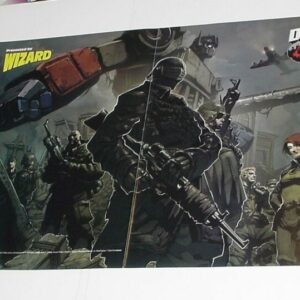Superman Poster #14 FRAMED Supergirl! Action Comics #252 (1959) Curt Swan
$74.99
Description
You are purchasing the item pictured, framed. Priority mail, tracking and $50 insurance is included with purchase. Item will be bagged to protect from dust, packed in packing peanuts and boxed. Just open box and hang it on the wall…makes a perfect gift!
Supergirl is a female counterpart to Superman. As his cousin, she shares his super powers and vulnerability to Kryptonite. She was created by writer Otto Binder and designed by artist Al Plastino in 1959. She first appeared in the Action Comics comic book series and later branched out into animation, film, television, and merchandising. In May 2011, Supergirl placed 94th on IGN’s list of the Top 100 Comic Book Heroes of All Time. Supergirl (Kryptonian name Kara Zor-El) plays a supporting role in various DC Comics publications, including Action Comics, Superman, and several comic book series unrelated to Superman. Supergirl dies in the 1985 limited series Crisis on Infinite Earths, and DC Comics subsequently rebooted the continuity of the DC Comics Universe, reestablishing Superman’s character as the sole survivor of Krypton’s destruction. After positive fan reaction to Super-Girl, the first recurring and most familiar version of Supergirl debuted in 1959. Kara Zor-El first appeared in Action Comics #252 (May 1959). The story that introduced the character was drawn by Al Plastino and written by Otto Binder, who had also created Mary Marvel, Captain Marvel’s sister and female spinoff. Like Supergirl, Mary Marvel was a teen-age female version of an adult male superhero, wearing a costume that was identical to the older character’s other than substituting a short skirt for tight trousers. Reaction at the D.C. Comics offices to Supergirl’s first appearance was tremendous, with thousands of positive letters pouring in. Kara Zor-El is the last survivor of Argo City, which had survived the explosion of the planet Krypton and drifted through space. When the inhabitants of the colony are slain by Green Kryptonite, which was released by meteorites striking the lead barrier, Kara is sent to Earth by her father Zor-El to be raised by her cousin Kal-El (Superman). Fearing that she might not be recognized by Superman, Kara’s parents provide a costume based on the Man of Steel’s own. On Earth, Kara acquires powers identical to Superman’s and adopts the secret identity of Linda Lee, a resident of Midvale Orphanage. She conceals her blonde hair beneath a brunette wig and functions as Supergirl only in secret, at Superman’s request, until she can gain, in his opinion, sufficient control of her powers. After she is adopted by Fred and Edna Danvers, Superman decides his cousin is ready to begin operating openly as Supergirl. Douglas Curtis Swan (February 17, 1920 – June 17, 1996) was an American comic book artist. The artist most associated with Superman during the period fans and historians call the Silver Age of comic books, Swan produced hundreds of covers and stories from the 1950s through the 1980s. Initially, Swan drew many different features, including “Tommy Tomorrow” and “Gangbusters”, but slowly he began gravitating towards the Superman line of books. His first job pencilling the iconic character was for Superman #51 (March–April 1948). Many comics of the 1940s and 1950s lacked contributor credits, but research shows that Swan began pencilling the Superboy series with its fifth issue in 1949. Swan always felt that his breakthrough came when he was assigned the art duties on Superman’s Pal, Jimmy Olsen, in 1954. In the view of comics historian Les Daniels, Swan became the definitive artist of Superman in the early 1960s with a “new look” to the character that replaced Wayne Boring’s version. Swan and writer Jim Shooter crafted the story “Superman’s Race With the Flash!” in Superman #199 (Aug. 1967) which featured the first race between the Flash and Superman, two characters known for their super-speed powers. Over the years, Swan was a remarkably consistent and prolific artist, often illustrating two or more titles per month. Swan remained as artist of Superman when Julius Schwartz became the editor of the title with issue #233 (Jan. 1971), and writer Denny O’Neil streamlined the Superman mythos, starting with the elimination of Kryptonite. Among Swan’s contributions to the Superman mythos, he and writer Cary Bates co-created the supervillains Terra-Man and the 1970s version of the Toyman as well as the superhero Vartox. Writer Martin Pasko and Swan created the Master Jailer character in Superman #331(January 1979).
>PAN>Frame is shrinkwrapped until time of purchase. Ships boxed with packing peanuts.
THE PERFECT GIFT!
Related products
-

Darkness Poster # 4 Dale Keown Darklings in Chains Pitt Hulk
$29.99 Add to cart -


Ultimate Spider-Man Thing Wolverine Poster David Finch X-Men Fantastic Four
$29.99 Add to cart -


Transformers G.I. Joe Poster Pat Lee GI Optimus Prime Snake Eyes
$39.99 Add to cart -


CrossGen Poster #18 Arwyn Greg Land Sojourn Bow of Ayden
$29.99 Add to cart




